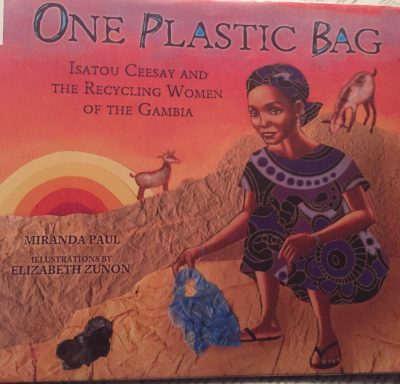- Title: One Plastic Bag: Isatou Ceesay and the Recycling Women of Gambia
- Author(s): Miranda Paul
- Illustrator/Photographer: Elizabeth Zunon
- Publisher and Year: Millbrook Press, 2015
- Number of pages: 28
- Tags: Culture, Diversity, Non-Fiction, Picture Book, K-5, Morgan Houk
- Genre: Non-Fiction
- Analysis:
 This is a true story about a woman from Njau, Gambia. Her name is Isatou Ceesay. Isatou walks to pick fruit and brings it back to her village in a palm-leaf basket. On her way to her village, the basket breaks and the fruit tumbles to the ground. Nearby, she finds a plastic bag in which she is unfamiliar with. She realizes that she can carry her fruit in the plastic bag and brings it back to her village to show her grandmother. Isatou’s grandmother is displeased with the bag, telling Isatou that it is made of plastic and there is a lot of plastic in the city. As the days pass, Isatou notices more and more people utilizing these plastic bags. Isatou begins using plastic bags to carry all of her belongings and when the bags would break she would leave them on the ground thinking they will disappear into the dirt just like her palm-leaf basket did. The other villagers believe this to be true as well but that is not the case. The plastic bags do not
This is a true story about a woman from Njau, Gambia. Her name is Isatou Ceesay. Isatou walks to pick fruit and brings it back to her village in a palm-leaf basket. On her way to her village, the basket breaks and the fruit tumbles to the ground. Nearby, she finds a plastic bag in which she is unfamiliar with. She realizes that she can carry her fruit in the plastic bag and brings it back to her village to show her grandmother. Isatou’s grandmother is displeased with the bag, telling Isatou that it is made of plastic and there is a lot of plastic in the city. As the days pass, Isatou notices more and more people utilizing these plastic bags. Isatou begins using plastic bags to carry all of her belongings and when the bags would break she would leave them on the ground thinking they will disappear into the dirt just like her palm-leaf basket did. The other villagers believe this to be true as well but that is not the case. The plastic bags do not  decompose and they begin piling up in many places, making her village ugly. The goats in the village start to get sick because they are eating the plastic bags. Isatou knows she has to pick up the bags around the village and make use of them. She started crocheting them into little purses and brings them to the city to sell. People love the purses and her village is beautiful again.
decompose and they begin piling up in many places, making her village ugly. The goats in the village start to get sick because they are eating the plastic bags. Isatou knows she has to pick up the bags around the village and make use of them. She started crocheting them into little purses and brings them to the city to sell. People love the purses and her village is beautiful again.
The ideological framework taking place in the text portrays the issue of power between people living in the rural setting and the people living in the urban setting. The people living out in the country are unfamiliar with plastic bags because they have been making their own baskets to carry things in for centuries. In contrast, the people living in the city have an abundance of plastic bags and also have enough money to buy the purses that Isatou made. It appears the city dwellers hold the power in that they have more money and ultimately help Isatou’s village become beautiful again by purchasing the recycled purses. It also talks about the social justice issue of the environment. This book can teach students about littering and what that can do to a community. It can also teach students about the importance of recycling and reusing the things that we incorporate into our everyday lives.
This book could also act as a window into an African culture that many students in the United States may not be aware of. The fact that Isatou is walking with a basket on her head to go pick fruit is very different than just driving to the supermarket and getting an apple from the produce section. The people living in the village also have many goats which could also be unusual to students living in the U.S.
The illustrations are drawn with beautiful bright colors and it appears that the plastic bags shown in the story are real-life photographs pasted onto the page. The clothes on the characters are very bright with intricate African patterns. In terms of the ideational framework of the characters, Isatou is rarely smiling and actually appears to have a concerned look on her face throughout the majority of the story. The characters are also drawn with a thin outline causing them to almost look as though they are a part of landscape around them.
